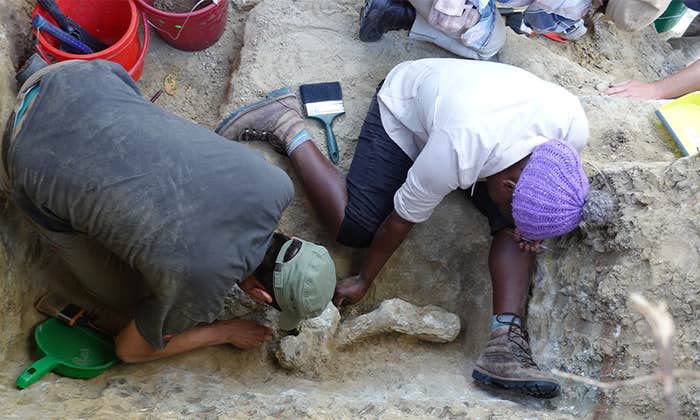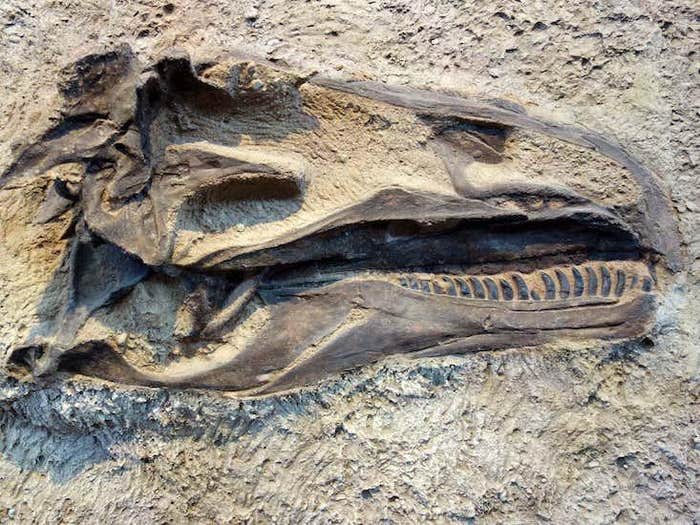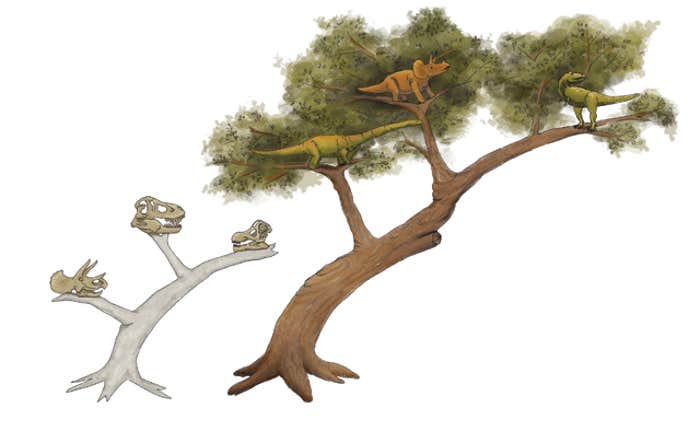The swifts arrive with thunder at their backs. Winter birds, they appear, loudly, and in great numbers, pursuing the emerging insect swarms just as the wet season begins after more than four months without rain. The arrival of the migratory birds marks the return of fertility and life, the continuation of a seasonal pattern that will last for millions of years to come.
The birds barrel through the mountain air of the East African highlands that will one day be part of Kenya and Ethiopia. The rise of these highlands, along with that of the Tibetan plateau thousands of miles away, has diverted the winds that once watered northwestern Africa, changing the patterns of rainfall across the region, and beginning the slow decline of the Sahara and Sahel into desert.
In Kanapoi, an area in what is now northwestern Kenya, Lake Lonyumun is spread wide and shallow, well over 300 kilometers from north to south and some 100 kilometers wide. It fills a vast crack in the continent, the East African Rift. It is fed by rivers that carve through a base of laminated claystones, dense assemblages of mollusk shells, and thick, solidified sandbars, precursors to rivers that will still exist in the modern day—the Omo, the Turkwel, and the wide and gentle Kerio.

The rain brings creatures out from hiding. In a fiery flash, a kingfisher breaks the river surface, feathers silvered with sunken air. Rebounding from the splash it has made with a fish in its beak, it flaps downstream to find a place to perch. Shovelnose frogs, fat little things, lumpy-backed and moss-colored, come together to mate, the male climbing on the back of the female as she digs down into the ground away from the river. Mice scamper through the greening grass, wary of the ambush of small carnivores—dwarf mongooses, dark-striped genets, and the earliest Felis, the wild ancestor of the domestic cat.
The low-running sleek of otters slide through the water, and the rain intensifies, as if it will never end. Its splashes form a low-lying fog of spray across Lake Lonyumun. The bull otter Torolutra, as big as a sea otter, and a hunter of fish—catfish, lokel, and the young of the idji—is very much at home in the rippling current. Wherever Torolutra are found, there are also their bigger cousins—bear otters.
With its muscular, flattened tail, an Enhydriodon swimming in the river would seem to be a floating, mossy log until it coils into a gleaming arch and dives. Searching for hard-shelled prey—mollusks, crabs, and the like—there are two species of bear otter in Kanapoi. Both have rounded pestles for teeth and use them to crush the same type of prey. It is believed that the two species can coexist only by dividing up their prey by size—the smaller of the bear otters going after younger individuals and smaller species of shellfish. The larger, E. dikikae, has the dimensions of a modern lion—two meters from whisker to tail and some 200 kilograms in weight.
What distinguishes us from other animals? There was no moment at which humanity suddenly arose.
Beneath the water, half buried in sediment, are round freshwater mussels, Coelatura, and the giant otter is searching for these. The juveniles are too small to concern the otter, but full-grown Coelatura are up to 6 centimeters long—a nutritious snack even if packaged with a crunch. Enhydriodon are less exclusively aquatic than most of their otter relatives, spending time relaxing on the bank, but still rely on the presence of large bodies of water in which to find their food.
A plunge from a kingfisher hardly causes a splash in the current. It emerges and lands on the back of a giant, silhouetted beast. The metallic blue bird stares at the water, taking advantage of this new fishing platform, which appears to be entirely unconcerned about its new associate. Two and a half meters at the shoulder, it stands cautiously in the muddy shallows, wary of the possible presence of gigantic horned crocodiles. Its short, whorled hair is matted down by the rain, with dark, long-lashed eyes shadowed by two bulbous projections. From the top of its head emerge two more, curving outward and backward to give the impression of an upturned sliver of a crescent moon. Not all giraffids are slender and long-necked; Sivatherium has the stockiness of an ox.
Around the banks of the Kerio, the rain has corralled the dust into a sheen of clay, but the slopes of rising hillocks are kept drier by well-drained sand. The land undulates, the higher ground sparsely specked with tree-shrubs and meadows of grass, while damper gullies are filled with forbs—non-grass fodder plants. Trees form a snaking avenue disclosing the course of the river for miles around. Where the Kerio River slows and drains into Lake Lonyumun, the water table is closer to the surface, and the canopy descends; shrubs compete with the trees, dissolving into thickets interspersed with wet, sandy ground, robed in sedges.
The trouble with taxonomic labels is that they, like communities of organisms, aren’t constant through time.
Proboscideans are diverse. There is not just Loxodonta adaurora, closely related to and barely distinguishable from the African elephant, but also Elephas ekorensis, a cousin of Indian elephants and mammoths. Among the trees strut stately, short-legged Anancus with their long, straight, forklift-truck tusks that almost touch the ground, and unlikely Deinotherium, whose short tusks curve backward and are used to scrape bark from trees. The skeleton of a dead tree is enticingly scarred, a low hollow revealing where the interior has rotted away, leaving only the hard outer tissue and a faintly fungal reek. Within, a family of nocturnal mastiff bats sleeps. When night falls and the swifts rise to sleep at higher altitudes, these bats will take over the relentless pursuit of the flying insects over Lake Lonyumun.
A stone’s throw from the eastern bank of the Kerio is a low patch of tree-shrubs. Acacia shade dapples the ground, while above, paths of light run like snail trails where the crowns fail to touch. A scream of alarm from a turaco sets a commotion among a troop of Australopithecus. Disturbed from chewing on leaves, the hominins scramble to their feet and run to climb lianas to safety in a spreading, broad-trunked acacia. Hostile smiles display their enormous canines as they hold on to the branches and lean over at the source of their fear and anger, while the swifts circle overhead in their endless ringing dance. There is something threatening them from low in the grass—a python, for which an australopithecine would be a good-sized meal.
The body hair of the upright Australopithecus is long. Their faces are ape-like, with jaws that project forward, and a sloping forehead tapering the head behind strong brows, to thick necks. The tallest are only about 150 centimeters tall, the same size as a chimpanzee, though they are less muscular, and there is a much bigger size difference between males and females than in modern humans. Their feet are not yet perfect for running; australopithecines have a slightly in-turned stance, helping them to climb the trees in which they sleep.
Having lost the initiative, the python retreats toward the river once more, sliding back toward the cracked trunk and buttressed roots of an echoke fig tree as the rain starts up again. The australopithecines in the tree calm now, but remain in the branches, too spooked to return to the ground any time soon.
Australopithecus anamensis is the earliest species to be unarguably more closely related to humans than to chimpanzees and bonobos. A few other candidates are older, but there are disputes about whether they are closer to chimpanzees or humans, or whether they split off from our lineage earlier than chimpanzees. The life of Australopithecus anamensis is the beginning of the evolution of an initially diverse group of which we are the last survivors.
Ever since the earliest attempts at classifying the natural world, humans have been labeled separately from the rest of life, as something apart, something special. The trouble with taxonomic labels is that they, like communities of organisms, are not constant through time. In the modern day the distinction between humankind and our nearest relatives, the genus Pan, comprising chimpanzees and bonobos, is clear.

Were we to look at the population of apes that existed before the ancestors of chimpanzees and humans went their separate ways, we would see a single species, and we might give that species a name. Frequently, when a new species is born, it results from “budding”—an isolated population of a species changing relatively rapidly, with the ancestral species persisting in every meaningful way elsewhere. In such a case, we might continue to use the original name for the relatively unchanged population, but from the perspective of the “new” species, the number of generations from the pool of shared ancestors is hardly distinguishable. It is only with the benefit of geological hindsight that we can determine that a population in a slice of past time should be considered to be different. In real time, a species is a dynamic plurality, the sum of its component populations and individuals within and between which genes flow.
For humans, defining the point at which we are confident of claiming “humanity” is difficult. What, after all, distinguishes us from other animals? There was no moment at which humanity suddenly arose—the populations that led to Pan and the populations that led to Homo did not undergo a sudden shift—the mixing of two populations simply reduced to the point where no genes flowed. We, like every other species, are the culmination of a series of partial replacements, the deaths and births of individuals in an ever-shifting population, with a continuity back in time and forward, connecting all living things together.
To talk of the first humans is to hammer a signpost into an ancient river saying “no humans beyond this point,” no matter the ever-flowing stream around its base. There is nothing essential to humanity, no single feature that intrinsically caused one creature to be a human where its parents were not. If we were to fast-forward, accelerate through time and follow these Australopithecus anamensis as the shared average features of the community shift into those of Australopithecus afarensis, the unimportance—or at least ambiguity—of this notion of species along the axis of time would be laid bare. In the time dimension, distinctions between Linnean ranks become meaningless. However hard you try to define every point before the signpost as non-human, and every point after the post as human, the river flows continually onward.
Ever since our emergence, we have been altering our worlds to suit our biological requirements.
Australopithecus anamensis are among the first creatures we find within that river of humanity more closely related to us than to anything else that exists in the modern day. No doubt as capable as chimpanzees with simple tools like stone hammers and anvils, they nevertheless predate the earliest human-knapped flint tools by half a million years. There are large body-size differences between males and females within their mixed social groups. As they shift into Australopithecus afarensis, their canines will reduce both in root size and in the extremity of their shape, the enamel will thicken, and the jaws shift to be wider set. Precisely how the australopithecines and later hominins grew and evolved in such a way as produced us is not well known; the course of the river has yet to be fully charted, and several paths will dry and evanesce to nothing, but Homo sapiens will appear not too far from its headwaters in the East African Rift.
The same is true of so many creatures in the cradle of Kanapoi. Those African elephants that can be found on the plains of Kanapoi, Loxodonta adaurora, are close relatives of modern African elephants, Loxodonta africana, but are a lineage that never made it to the present. The impala that graze on the grasslands are similar enough to modern impala to be assigned the same genus, Aepyceros, and are probably their direct ancestors. The giraffes here are almost identical to modern giraffes, a little smaller and with smoother foreheads, but with the unmistakable loping stride and long, ungainly necks.
Much, of course, will change in the interim, and many species will be lost. As creatures adapt and evolve, their niche-space shifts, and some will come to overlap and compete. Circumstantial evidence has led some to suggest that the bear otters of East Africa will ultimately meet their extinction because of hominins. The idea is that as the genus Homo arises, as tools become an ever-more important part of the ecology of hominins, the diet of humans will change from the herbivory of the australopithecines. This ever-more carnivorous niche will bring hominins into conflict with the other carnivores of East Africa, including the bear otters. The rocks record a decline in large carnivore number and diversity that peaks in intensity 2 million years before the present, just as the first species of Homo emerge from the Rift. The large carnivores that will survive to the present are the specialist meat-eaters—big cats, hyenas, and wild dogs—that prey on large, dangerous herbivores. Those that will be lost—otters, a bear, giant civets—are mixed feeders on plants, mollusks, fish, fruit—precisely the niche that we will ultimately make our own. If this is true, the bear otters of Kanapoi are destined to become perhaps the earliest species extinction caused by hominins.
Nature lovers often see the world as a dichotomy between some primordial, natural Eden and the cityscapes of the modern day. Humanity is seen as an external force, something separate to the ideal of “nature,” which must be escaped to experience the wild, and something which can only wreak a destructive force on the world. To take this view is to deny the naturality of humanity. Ever since our emergence, we have been fighting our corner, exploiting our own ecological niche, part of which is as a modifier of habitats, an engineer of ecosystems, altering the worlds in which we find ourselves to suit our biological requirements.
In Kanapoi, we see one of the earliest worlds largely recognizable as our own. The continents are almost at their modern positions, and the world is cool and ice-capped. Pliocene Earth resembles the recent interglacial periods, including the modern day. Kanapoi is a cradle, but not just of humanity. We are but one of the families that benefited from the ecological variability of East Africa, part of the earliest endemic African mammal community, with carnivores like hyenas, genets, mongooses, and wild cats. Among hoofed mammals, zebras, wildebeest, elephants, antelopes, and giraffes all trace their heritage to the shores of Lake Lonyumun at Kanapoi. Even among primates, Kanapoi is not just home to hominins. Early baboons, slight, long-limbed and resembling mangabeys are here, too. The lake makes Kanapoi unique even among contemporaneous African fossil sites; no other site has such a diversity of aquatic and aerial birds.
The swifts still wheel over the Kerio valley, and stilts and storks still stride along the edge of the great rift lake. East Africa still has some of the most suitable landscape for dense concentrations of large herbivores in the world, and indeed the herbivores that live there are still very diverse.
Many of the great beasts of the Pliocene past are long gone—sivathere and bear otter, giant pig, and scimitar-toothed cat—and no intrinsic trait guarantees the continued survival of those still alive in our present. But even now, in the Rift Valley, there are glimpses of familiarity with what has gone so recently before, of the conditions in which we as humans slowly emerged. The planet may have lived long before us, but Kanapoi is the first world that humanity can claim as home. ![]()
Thomas Halliday is a paleontologist and evolutionary biologist. He holds a Leverhulme Early Career Fellowship at the University of Birmingham, and is a scientific associate of the Natural History Museum. His research combines theoretical and real data to investigate long-term patterns in the fossil record, particularly in mammals.
From the book OTHERLANDS: A Journey Through Earth’s Extinct Worlds by Thomas Halliday. Copyright © 2022 by Thomas Halliday. Published by arrangement with Random House, an imprint and division of Penguin Random House LLC.
Lead art: Wikimedia Commons
















